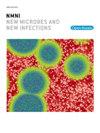Modelling of knowledge and attitudes as key determinants of Mpox prevention practices among university students in Ghana: a cross-sectional analysis
IF 2.9
Q2 INFECTIOUS DISEASES
引用次数: 0
Abstract
Introduction
Mpox has surfaced as a primary health problem since the global outbreak in 2022. This study sought to evaluate and also use structural equation modelling (SEM) to predict the knowledge, attitudes, and preventive practices concerning Mpox among students.
Methods
A descriptive cross-sectional survey was conducted with 469 students at the University for Development Studies. Data were collected using a structured questionnaire with SEM and cumulative percentage employed to analyze and predict both knowledge and attitudes on preventive practices among university students.
Results
A significant majority (84.2 %) correctly identified Mpox as an infectious disease caused by the Mpox virus, though 55.0 % incorrectly believed it to be the same as smallpox. The overall knowledge of Mpox among university students was poor (59.1 %), with 40.9 % demonstrating either acceptable (32.4 %) or excellent (8.5 %) levels of knowledge. Despite this, 77 % of students had a favorable attitude towards the disease. Preventive practices were predominantly excellent, with 78.7 % of students exhibiting excellent practices, while only 3.8 % demonstrated poor practices. SEM revealed a positive, statistically significant association between knowledge (β = 0.23, P < 0.001), attitude (β = 0.38, P < 0.001), and preventive practices. Additionally, a strong positive effect was found between knowledge and attitudes towards Mpox (β = 0.50, P < 0.001).
Conclusion
The study emphasizes that although students have limited knowledge about Mpox, their positive attitudes greatly aid in the implementation of successful preventive measures. Improving knowledge may result in even better preventive actions, highlighting the necessity of focused educational programmes to raise students' knowledge of Mpox.
知识和态度作为加纳大学生预防麻疹实践的关键决定因素的建模:横断面分析
自2022年全球暴发以来,天花已成为一个主要卫生问题。本研究试图评估并使用结构方程模型(SEM)来预测学生对Mpox的知识、态度和预防措施。方法对发展研究大学469名学生进行描述性横断面调查。数据收集采用结构化问卷与SEM和累积百分比采用分析和预测知识和态度的预防措施的大学生。结果绝大多数(84.2%)的人正确识别出m痘是由m痘病毒引起的传染病,55.0%的人错误地认为它与天花相同。大学生对Mpox的总体知识水平较差(59.1%),其中40.9%的人表现出可接受(32.4%)或优秀(8.5%)的知识水平。尽管如此,77%的学生对这种疾病持赞成态度。预防措施主要是优秀的,78.7%的学生表现出优秀的做法,而只有3.8%的学生表现出不良的做法。扫描电镜显示,知识与知识之间呈正相关,具有统计学意义(β = 0.23, P <;0.001),态度(β = 0.38, P <;0.001),以及预防措施。此外,对Mpox的知识和态度之间存在强烈的正向影响(β = 0.50, P <;0.001)。结论本研究强调,虽然学生对Mpox的了解有限,但他们的积极态度对预防措施的成功实施有很大的帮助。提高知识可能导致更好的预防行动,突出强调有重点的教育方案的必要性,以提高学生对麻疹的认识。
本文章由计算机程序翻译,如有差异,请以英文原文为准。
求助全文
约1分钟内获得全文
求助全文
来源期刊

New Microbes and New Infections
Medicine-Infectious Diseases
CiteScore
10.00
自引率
2.50%
发文量
91
审稿时长
114 days
 求助内容:
求助内容: 应助结果提醒方式:
应助结果提醒方式:


